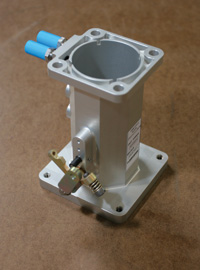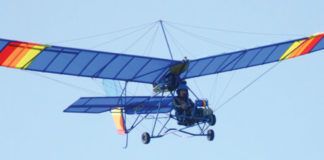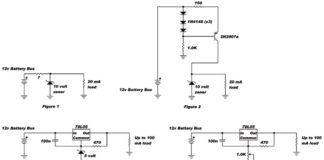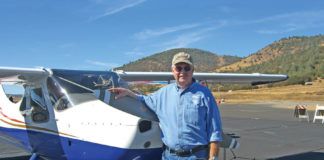
Ask most builders and pilots who have chosen alternative powerplants derived from modern car engines to explain their choice, and you wont be far into the discussion when electronic engine management comes up. Fully automatic fuel injection. Variable ignition timing with a hot spark far better than any magneto could produce. These are the big reasons to want something beyond a traditional engine with a carburetor (or mechanical injection) and mags.
Cited as upsides are lower maintenance costs-in theory, a modern injection and ignition system will require less care than a mechanism-laden magneto or carburetor-and reduced pilot workload. Pilots have long desired the combination of power and efficiency brought by a constant-speed (or adjustable-pitch) prop and precise fuel metering without the need to mother-hen the throttle, prop and mixture controls. Not just in flight, but for the dreaded hot start. Wouldnt it be nice if we could get in, turn the key, start the engine and fly?
The Future Is Now
Until recently, electronic engine management has been the province of auto-engine conversions (at least those that start with such devices, excepting the Corvair and Ford V-6s, for example) and a few hardy builders who have adapted electronic systems to traditional aircraft engines. More popular, of course, are electronic ignitions that feature variable timing, reliable hot starting (from a hot spark right at top-dead-center [TDC]) and efficiency gains.
More than a decade ago, Continental and Lycoming announced new FADECs for the certified market, but they really failed to sell in big numbers and were, at the time, too expensive for most homebuilts. Meanwhile, north of Seattle, Precision Airmotive, current owner of the Bendix mechanical fuel injection systems and, until last year, the venerable Marvel carburetors, sat quietly and developed its own system. Intended for low-horsepower trainers with the primary focus being ease of use for new pilots and reduced maintenance costs, the Eagle EMS is now being promoted in the Experimental market. Alan Jesmer, Precisions marketing director, pointed out: We worked on the certified version but couldn’t get OEM interest. Not surprising when you consider the not-invented-here bias of many airframe manufacturers.
In 2006, Precision began displaying the system at airshows to ramp up interest. Finally, in late summer 2008, Eagles were starting to be delivered to builders and engine shops: Two are currently set up for new builds and conversions, Aero Sport Power in Canada and G&N Engines, in Griffith, Indiana. When we visited a factory prototype of sorts, the RV-6A, it had amassed many hours flying with O-360-based Eagle power, and a second aircraft, an RV-8, was also flying. All told, 14 systems were out in the world as of late 2008.
Configure This
In terms of general layout, the Eagle is reasonably simple. A main electronic control unit (measuring 18 x 6 x 2.5 inches) is meant to be located in the engine compartment. A power management unit (measuring 5.5 x 3.3 x 1.4 inches) is also to be located on the hot side of the firewall. Two coil units (measuring 4.1 x 5 x 3.4 inches) have flanges to be mounted in the engine compartment; the installations Ive seen have them clamped to the engine mount. The other main components include two speed sensors, which mount to each magneto pad, a fuel distribution block, and a throttle body the same length as a Precision Silver Hawk throttle body.
Fuel is delivered by single electronic pulse-type injectors at each cylinder, screwed into the conventional injector holes above the intake ports. The fuel system between the tanks and the injectors is mostly standard Lycoming, with mechanical and electric fuel pumps and no need for a return line. The fuel distribution block takes the place of the flow divider normally found along the engines spine, and houses a 10-micron filter and dual fuel-pressure sensors.
For sensors, the ECU depends on the twin speed sensors for engine-speed and TDC reference, and the aforementioned twin fuel-pressure senders. In addition, the Eagle EMS has dual barometric pressure sensors plus twin incoming air temp sensors on the throttle body. Parallel pneumatic connections between the ECU and the throttle body feed twin manifold-pressure sensors inside. Except for the injectors themselves, virtually everything in the Eagle EMS is redundant. To coordinate with your existing engine instrumentation, the EMS outputs a pulsed mag signal for an electronic tachometer, and even emulates a FloScan fuel-flow transducer for your engine monitor. Nice.
Power management is always a concern when in order to keep the engine running, the aircrafts electrical system has to function. Precision has taken an interesting tack here: Rather than set up a backup electrical system or battery, it requires a separate battery that runs the system full time-it is the primary source of power. The aircrafts electrical system merely keeps this batterys charge topped off. Why? Because the transition from ships power to backup caused a hiccup, which is eliminated when you’re running on your backup all the while. The battery is supplied by the buider, and the system pulls 1.6 amps running.
Trying to Simplify
Precisions ECU contains two computers with parallel maps. In electronic engine control parlance, these maps are really lookup tables. Imagine an Excel spreadsheet, with the row across the top being manifold pressure and the column along the left side as engine speed. For any combination of engine speed and manifold pressure-the two variables that most influence power output at rich-of-peak EGTs-there is a value determining how long to hold each injector open. With progressively more manifold pressure and/or rpm, the value gets bigger and the injector stays open longer, providing more fuel.
This simplified reference system is used on virtually all modern motorcycles to great effect, and is considered open loop. (Cars need much tighter control for emissions needs; most run in a pure closed-loop mode much of the time.) The Eagle EMS does not monitor EGTs, so it cant see the effect of the fuel delivery, though it does watch two CHTs to protect the engine from damage-it can retard ignition timing or add more fuel to keep within predetermined CHT limits. However, until the preset CHT limit is reached, the system works solely off the internal map.
Igniting the Possibilities
On the ignition side, Precision follows standard modern practice, with user-defined advance curves and an intelligent starting procedure.
Precisions engine-start capability includes a separate algorithm that determines whether the engine is hot or cold. If its cold, the injectors pulse more often to provide a priming function, while the ignition fires multiple times at TDC to get the engine running. Once started, the engine returns to normal cold-start injection durations, and the timing gradually builds to follow the preset map. When the engine is hot, the priming function is not used; however, because the fuel lines right up to the injectors are at full system pressure, vapor lock (the reason most injection engines are hard to start hot) is effectively eliminated.
Variables for Experimenters
Two elegant ideas underpin the Eagle EMS for homebuilders. First, Precisions engineers realized that even though the map-based system works well for most conditions, there are times when the pilot needs to have a hand in the proceedings. Thats why you’ll find a knob on the instrument panel allowing a manual skew of the injection map. Depending on the setup, the knob can either go rich or lean from the base map, and its up to the builder to decide. The total skew is 15% of fuel flow (ignition is not affected).
But even better for knowledgeable builders, the base map itself can be modified. Lets say you find that a certain manifold pressure/rpm combination makes the engine run richer or leaner than youd like. The solution is to alter the fuel duration in that cell of the lookup table to get what you want. Naturally, going way off the base map opens you up to mixtures that could damage the engine under certain conditions, so it pays to experiment carefully, but its good news to engine-savvy builders that the base map can be just a starting point to achieving ideal mixture control.
Moreover, the ignition map can be highly tailored. You can select the maximum advance and the general shape of the curve with reference to manifold pressure/rpm combinations.
So Now We Fly It
In truth, Ive been hammering on Precision to let me fly the system for a couple of years. Finally, this summer, the company’s testbed, a 1998 Vans RV-6A owned by Bob Newell was available for a flight. Fitted with a fresh O-360, the testbed has seen many, many flights getting the system validated in a homebuilt, and it shows in the seamless nature of the system. After a slightly rocky initial startup-setting the throttle position is important plus the airplane had been sitting for awhile-the engine ran smoothly and cleanly, with expected EGTs (well balanced) and otherwise normal temps and pressures during the warm-up, taxi and runup.
Sometimes we use the term FADEC incautiously. In this case, its not full authority in the sense that the constant-speed propeller is still managed by the pilot. Next to the blue knob in the throttle bracket was a hole-no red knob at all. Runup procedures involve checking each ignition system independently as you would mags, and ensuring that the ships electrical system is healthy.
On application of takeoff power, the Eagle system responds beautifully. The RV accelerated normally as the EGTs came up, the highest reaching 1460 F. As we all know, the absolute value of EGTs is unimportant because of all the variables of probes and probe placement, but this struck me as slightly too lean at high power, despite the mixture knob being in the full-rich slot. By 1000 feet AGL, the hottest CHT was 360 at a fuel flow of 14.4 gph. As we climbed, the fuel flow gradually and smoothly decreased as did the manifold pressure. Climbing through 2500 feet AGL, there was 25 inches of manifold pressure and 2500 rpm, fuel flow of 14 gph even, EGT steady at 1430 and the CHT climbing through 380. At the top of the climb, the hottest CHT was 410 with the EGTs all in the mid-1400s.
In the cruise phase, with the mixture knob pulled back to the 2.5 position, fuel flow fell to 9.6 gph, EGTs rose to the high 1400s and low 1500s, with the hottest CHT settling on 376. The engine was butter smooth. Response to changes in throttle position and rpm were handled without a hitch and minus big EGT excursions. Its clear that all the time Precision spent on the dyno fine-tuning the base map has paid off.
But cruise is easy. Its the descent, maneuvering and landing phase that normally requires pilots to fiddle with the mixture when they should be looking outside. We descended with the mixture leaned, and the Eagle system tracked changes in manifold pressure well, with the EGTs remaining steady and even. In fact, the engine was well behaved all the way from the top of the descent to shutdown back at the hangar. As a precaution for a potential go-around, Bob reset the mixture knob to zero just before landing, but that was about all the mixture meddling he did the entire way down.
Worth the Effort?
The Eagle EMS lists for $8935 complete, and will be offered by Aero Sport Power and G&N as both retrofits and as fresh builds on Experimental engines. The final price is set by the shops, but remember that you’ll be getting credit for mags and a carburetor or fuel injection setup, so the final price delta will be lower by a useful amount.
According to Precision, the weight is about a wash, though there’s no denying that installation is going to be more demanding than a traditional setup. Will the Eagle pay for itself? Thats hard to say, but if you’re the type of pilot who isn’t always tweaking the mixture to get it just right, chances are that the EMS will run the engine overall more efficiently than you would, and at todays fuel costs the initial price delta doesn’t take all that long to cover. That the system is high tech and an experimenters delight is just a bonus.
For more information, call 360/651-8282, or visit www.precisionairmotive.com.




